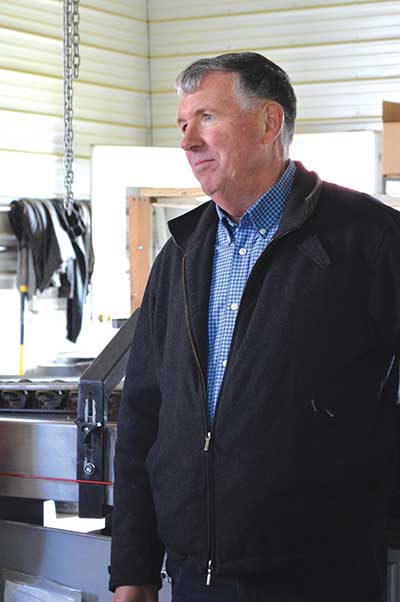 |
| Dick York’s love of agriculture inspired him to start Nature’s Circle Farm. |
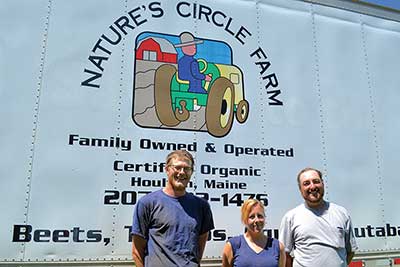 |
| Three of Nature’s Circle managers: left to right, Lowell Matthews, Meg York and Nicholas Fitzpatrick. |
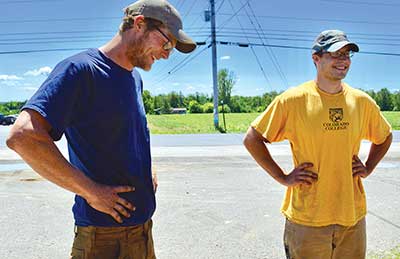 |
| Elliott Mooers (right), Matthews’ best friend since childhood, manages the H-2A workers. |
By Jean English; photos by the author
Nature’s Circle Farm is a 390-acre MOFGA-certified organic vegetable farm in New Limerick, Maine – 6 miles west of Houlton. According to its Facebook page, “We are everyday people, trying to make a living, trying to create a solid business plan, trying to boost our local economy, and to serve the people of our community.” That dedication to family and community is ever-present on the farm.
Dick York, who grew up on a conventional family farm in Aroostook County and always wanted to be involved in agriculture, started the operation in 1996 on 2 acres with his son Jamie. They tried marketing through a community supported agriculture (CSA) operation. In 1997, however, lacking sufficient local retail sales, York and about 15 other Aroostook County organic farmers developed a co-op to wholesale their products to a broader geographic clientele because all were having trouble selling enough product locally. Aroostook farmers Jim Cook and Jim Gerritsen were a big part of this effort, according to Dick’s daughter, Meg York.
“Jim Cook really inspired my father to grow,” says Meg. Cook was selling Maine produce in southern Maine and southern New England. “He got a contract with Whole Foods’ distribution center in Connecticut through Crown O’ Maine, and he told Dad they really wanted organic potatoes. At the same time, the Hannaford distribution center in South Portland had asked Dad to grow organic potatoes.” Those two markets encouraged York to increase his acreage.
York started out renting a small storage space, and then rented more and more space as the business grew, until he eventually bought a potato storage house.
The co-op has since folded, but development of those wholesale markets continued to stimulate the growth of Nature’s Circle Farm as the demand for organic grew – especially for certified seed and tablestock potatoes.
In addition to the farm, Dick York co-owns York’s of Houlton, a Ford and Toyota dealership, with his brother Jerry and his son Jamie (no longer involved in the farm). Dick is the sales manager there, and his income from that business helped fund the development of Nature’s Circle Farm. Meg sees some “ticket” like this as important in starting a farm.
Over time York added acreage and several varieties of other crops that store and ship well: winter squash, carrots, beets, parsnips, cabbage, turnip, rutabaga and wheat.
Today Nature’s Circle is an S corporation and is one of the largest organic, mixed vegetable farms in Maine, with about 200 acres in cash crops and another 100 rotated in cover crops.
Teamwork
Meg, a licensed social worker, started working for the farm in 2004 as a bookkeeper and marketer after her first child was born.
“I knew that I wanted to stay home with my daughter, no matter what it took,” says Meg. Her father suggested that she do some marketing, bookkeeping and the payroll for the farm. A full-time mother, she still stays home with her kids – now 15, 12 and 10 years old – while also doing all of the sales and marketing, a lot of the bookkeeping and some of the management of the farm, mostly from home. Her kids are on the weeding crew. She and Dick are now the major owners of the business.
A crew of about a dozen works full-time, year-round. During weeding season the farm may have up to 30 employees, and during harvest, 20 to 30 seasonal employees. Some work in the fields; others wash, inspect and pack. This year the farm hired four H-2A workers from Mexico for the first time. These temporary, nonimmigrant agricultural laborers “have been wonderful,” says Meg. “We love them.”
Nicholas Fitzpatrick, the main manager and another Nature’s Circle co-owner, “oversees the entire operation,” says Meg. “He is the backbone of the whole place. He’s a seventh-generation farmer; there’s a long history of Fitzpatrick potato farmers in Aroostook County. He came with a wealth of knowledge and has been awesome for our business. He’s very interested in production, yield and building up the soil.”
Lowell Matthews, Dick’s nephew and another farm co-owner, has been working on the farm since he was 19 years old. “We probably couldn’t function without Lowell,” says Meg. “He is aware of everything going on at the farm, and is there pretty much every day. He helps everyone whenever needed and has such a sunny disposition and positive attitude. He supervises crews, runs the packing shed, runs and fixes equipment and does a lot of the field work.”
Elliott Mooers, Matthews’ best friend since childhood, just started working on the farm this year, managing the H-2A workers. “Thank goodness we have Elliott,” says Meg. “When he started working with our H-2A workers, there was a major language barrier. He was able to communicate with them choppily using his high school and college Spanish. After five weeks, he was conversing with them fluently.”
Mooers grew up on an Aroostook County farm, studied sustainable agriculture at Colorado College and is very interested in learning more about crop production, including ways to minimize spraying. “I’m really on the organic train,” he says.
Fitzpatrick and Matthews are both mechanical and fix a lot of the equipment, Meg adds. “And Nick is really good about training people. He believes everybody can learn.”
Pauline White, who has been with the farm for about eight years, manages the weeding crew and is the squash manager. Nature’s Circle grows about 50 acres of winter squash, and White oversees all of that packing – “a huge job,” says Meg, since they have just one shed for squash. White has also started doing some in-state marketing – going to universities, for example, to see if they’d like to buy some local, organic product.
“Dividing up the management has been one of Nature’s Circle’s growing pains,” says Meg. “When the farm started really growing, my dad was committing a tremendous amount of his time, energy and effort into Nature’s Circle” at the same time that he was working at York’s of Houlton. “He had one manager to supervise everyone.”
With the addition of more land, crops and markets, especially over the last 10 years, the management structure has changed.
“It’s been interesting to try to figure it all out,” says Meg. Each manager has a specific job, but those jobs can overlap like a Venn diagram, with everyone helping each other “like a team,” she adds.
The managers try to meet frequently to communicate with one another, but given how busy everyone is during the harvest, they sometimes use group text messages instead of meetings.
Dick, now 70, has reduced his role in the last year or so and enjoys playing more golf.
“He still likes to do the accounts payable – he was an accounting major – and he advises us,” says Meg. “He’s like a consultant. He still oversees the whole business, but he’s not involved as much as he used to be.”
Dave Colson, MOFGA’s agricultural services director, says the farm embodies “success through diversity and investing in family management. Dick has done a good job in utilizing his family and finding good people to augment that. He supported the farm financially for many years. From my talks with Dick, I believe that serving the local community is truly one of his motivations. Plus he loves farming and the land.”
While Dick originally saw organic as a marketing opportunity, he now “embraces the organic mindset,” says Matthews, for the health of the consumer and the environment.
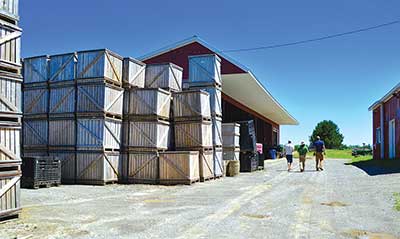 |
| Pallet boxes and an equipment barn on the left; part of the processing and storage facility on the right. |
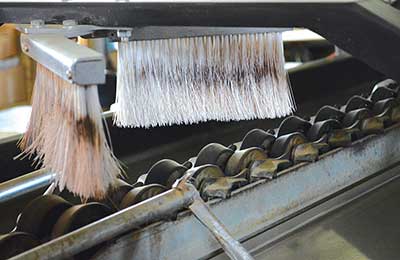 |
| Potatoes are brushed clean before being bagged. |
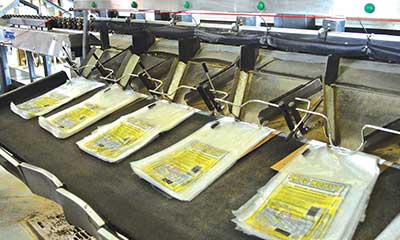 |
| Bags soon to be filled with potatoes. |
A Year on the Farm
One year runs into another on the farm, with no breaks. From January until late April, the crew packs and sends out seed and tablestock potatoes while also deciding what to plant where in the coming growing season. Double-certified seed potatoes (i.e., certified organic by MOFGA and certified by the state of Maine for pest control) have increased from 10 to about 25 percent of its potato sales.
They start winter squash, golden beets and most of their cabbage seedlings in four large greenhouses in early May. An E-Z seeder has helped seed cabbage more efficiently. They use Living Acres Organic Potting Soil as a seed starter mix.
Also in early May they start planting potatoes. Some are specialty varieties, such as Adirondack Red, Bora Valley, French Fingerling and Russian Banana Fingerling; others are traditional varieties, such as Yukon Gold, Kennebec and Dark Red Norland. After crop rotation and cultivation, the main pest control for potatoes is Entrust, with the active ingredient spinosad, derived from soil bacteria.
The crew transplants about 7 acres of winter squash – about a dozen varieties – around May 21. They tried growing the crop on black plastic mulch but stopped because the plastic was too difficult to pull up at the end of the season. They do start squash under row cover to exclude cucumber beetles and to protect the crop from sun, wind and cold. They also apply Surround (kaolin clay) to deter cucumber beetles.
Mooers is excited about the idea of growing some Blue Hubbard squash as a trap crop for cucumber beetles and vine borers, spraying only that variety rather than the whole field to kill the insects.
They brought in honeybees to pollinate the squash this year.
In late June or early July, beets go in, then rutabaga, and in late July, turnips.
“Late root crops do better here,” says Meg. “They size up the way we want them to, and develop less disease.
“We cultivate throughout the summer,” Meg continues; “endless cultivating! I can’t believe the investment in weeding attachments we have purchased in the last couple of years,” including a Reggie weeder to get in close to transplants. “That has cut down on hand weeding, but we still have all kinds of hand weeding starting in late June. That’s a big crew.”
They start harvesting early squash in the second week of August, when the H-2A workers cut mature squash from the vines with hand clippers and leave the crop in the field to season for a week or two. They cut the stems quite short to avoid damaging other fruit during storage. Once the squash is field-cured, four people place it on a conveyor, which moves it from the field into pallet boxes that can hold 1,200 pounds each.
“You have to be really careful with squash,” says Meg, including placing cushioning in the pallet box. At the top of the wagon, Mooers makes sure the squash moves gently from the conveyor into the boxes. To avoid putting too much weight on the squash, each pallet box is loaded with no more than about 1,000 pounds.
Butternut is the most popular variety in the United States, says Meg, because it produces more squash and fewer seeds than most varieties, and it is versatile and delicious.
By early September they have harvested about one-quarter of the squash crop, all of their early potatoes (about 4 acres), and some turnip and early cabbage. They start delivering to early markets then to get a foot in the door and for some much needed cash flow.
They move into their major potato harvest – 90 acres – by mid-September. They kill potato tops by flaming with propane and then harvest the tubers, finishing with the harvest in early November. Fingerlings have to be hand-picked, since they fall through the harvester.
Once squash and potatoes are out of the ground, life is a little more relaxed at Nature’s Circle. “The squash and potatoes are just huge,” says Meg. “Trying to figure out where everything is going to go; it’s so stressful.”
Rutabaga harvest comes next, and turnips are harvested last – into November. So the harvest runs from August into November, and packing and shipping occur from August until May – when it’s time to cut and plant potatoes again.
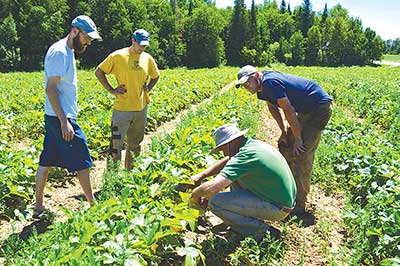 |
| Two of MOFGA’s agricultural services staff members, Caleb Goossen (left) and John Chartier (second from right), check a squash planting with Mooers and Matthews. |
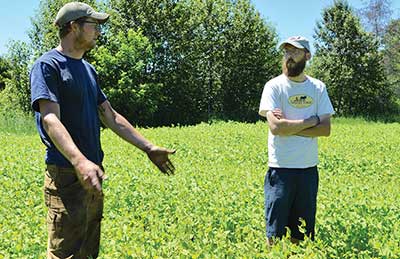 |
| Matthews, who says he’s “geeking out” about cover crops, talks with fellow geek Caleb Goossen of MOFGA. |
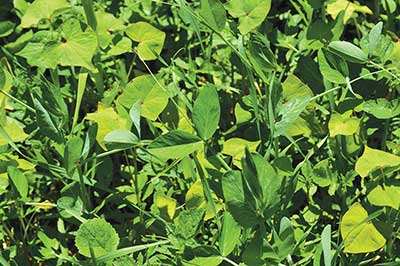 |
| Part of a 30-acre trial of a complex cover crop mix. |
Cover Crops, Crop Rotations and Soil Fertility
Crops grow in rotation so that potatoes are on the same ground only every third year. Aurora Mills & Farm, another MOFGA-certified organic farm, uses some of the rotated land to grow grain. Cover crops occupy more of the rotated land and include mostly clover. This year they also trialed a mix of medium red clover, spring peas, timothy, sorghum sudangrass, soybeans, cereal rye, desi chickpeas, berseem clover, plantain, okra, alfalfa and buckwheat, which seems to have done well. Seed of the mix cost $53 per acre from Green Cover Seed in Nebraska. The Southern Aroostook Soil and Water Conservation District, through a grant from the Maine Department of Environmental Protection, paid for 25 acres and the farm paid for 5 acres worth of seed for this experimental planting, which was followed with winter rye. Matthews is excited about this work. “I’ve been geeking out about” the cover crop mix, he says.
Legume cover crops provide some soil fertility, while pelletized poultry manure provides the bulk of the nutrients applied on the farm – an expense that “pretty much breaks us in the spring,” says Meg.
Packing, Storing and Shipping
Crops are cleaned and packed in a packing shed and are stored in a multi-department controlled-environment facility so that quality produce is available into the spring. Potatoes, for example, are washed, polished, graded, brushed, bagged and tagged, stacked on pallets and shipped. Both farm and packing facility are Good Agricultural Practices (GAP)-certified – an audit that verifies that the vegetables are produced, packed, handled and stored as safely as possible to minimize risks of harmful microbes.
Markets
Nature’s Circle sells through Crown O’ Maine and Farm Fresh cooperatives, to other farmers, to Hannaford and Whole Foods, and through Albert’s Organics and Gold Bell distributors. Its seed potatoes go to Johnny’s Selected Seeds, The Maine Potato Lady, Seeds of Change and Fedco’s Moose Tubers. A limited amount of produce is retailed from the farm.
Some of the No. 2 potatoes go to a processing plant in Florida in May, for pennies; some go to a local food bank; most go to local cattle.
Meg envisions continued growth, with Nature’s Circle packing and distributing for a community of Aroostook County organic farmers and providing a stable income for them – essentially continuing and expanding on her father’s original plan. She encourages growers with excess storage crops to contact her. For example, the farm runs out of its own beets in January and “we can sell every organic beet there is until April,” she says. This is the third year in which Nature’s Circle is distributing produce from about five MOFGA-certified organic growers from the Aroostook Amish community.
Meg thinks the business may expand beyond storage crops someday, shipping more perishable products straight from the field, and perhaps even investing in a chipper and starting an organic potato chip line to use some of the potatoes that don’t make the grade for the fresh market.
Economically, the business is not where the owners want it to be. Sales are just under $1 million, which is not enough, given the number of managers and the increase in minimum wage to $10 per hour this year and probably to $11 next year. That increase “is probably a good change for the state and the United States,” says Meg, “but it’s been extremely hard on our farm. Our workers’ comp is very expensive too. Payroll has grown to 25 percent.” Her goal is to increase sales to over $1 million – and, like all farms, to someday have everything grow well, to increase yields, to harvest everything perfectly and to improve storage. She can sell everything they can grow.
Continuously Supporting Community
Meg says that the Nature’s Circle farmers try to be as community minded as possible. They provide jobs and a lot of food to the community – including donations to Chamber of Commerce dinners, Houlton’s Potato Feast Days, Rotary auctions and more. “We just really want to provide our community with healthy, organic, nutritious food and try to help educate continuously on how important that is.”
They also want to continue to form a cohesive farm family and farm team, and continue to find markets that will improve their sustainability. “We are open to moving in new directions and moving with the times while continuing our creed of providing healthy, nutritious food,” Meg concludes.
Recipes from Nature’s Circle
Twice-baked Spaghetti Squash with Chili and Cheese
Cut the squash in half, scoop out the seeds and then bake the squash at 350 for an hour. Fork up spaghetti squash and add some olive oil, salt and pepper. Top with your favorite chili recipe and then Mexican cheese. Bake for another 20 minutes and then serve.
Butternut Squash Soup
In a blender, puree cooked butternut squash, onions fried in butter, chicken broth, nutmeg, salt and pepper. Simple and delicious.
What to Do with Rutabagas?
Enjoy mashed rutabaga, rutabaga fries, rutabaga mascarpone, and rutabaga and chicken pot pie.

